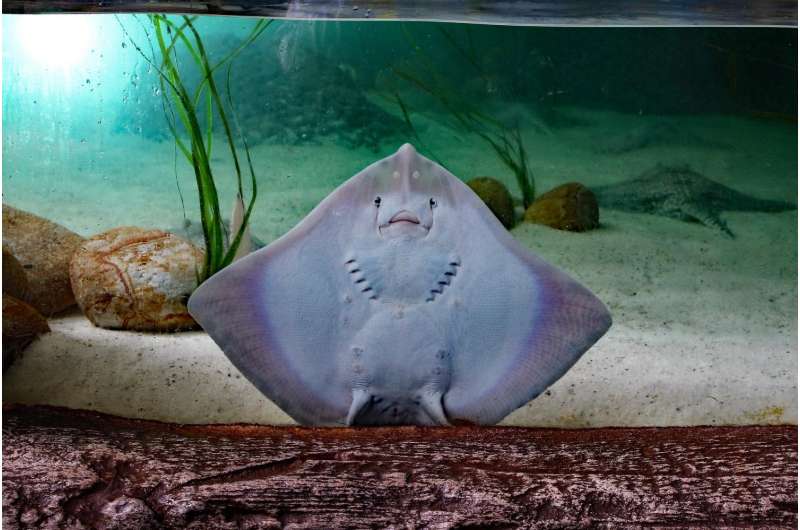Credit: CC0 Public Domain
(Phys.org)—A team of researchers from the University of Toronto and the University of Washington has discovered that at least one species of stingray chews its food before swallowing it. In their paper published in the journal Proceedings of the Royal Society B, the team describes their study of the creatures using high-speed video technology and what they learned about the platter-shaped predators.
Up till now, scientists have assumed that mammals are the only creatures that chew their food before they swallow it—but this, the researchers note, depends in part on how you define chewing. Birds, they note, have a gizzard for grinding up food, though technically it is not chewing in the usual sense, though similar. In this new effort, the research team has found that the ocellate river stingray, which lives in the Amazon River, chews its food in very human-like ways.
Intrigued when they learned that the stingrays often eat prey that would seem to require chewing such as insects and mollusks, the team obtained several samples of them for study in their lab. They placed them in a tank with a see-through glass bottom, as the stingray mouth is on its underside. The researchers then filmed them as they captured three kinds of food—soft, medium and hard—chewed it, and then swallowed it. More specifically, they found that the stingrays first grabbed their prey after pulling it in using suction they created by undulating their bodies, and then moved the left and right parts of their jaws back and forth to create multiple angles for biting and tearing. They found that the stingrays also moved their lower and upper jaws independently. Taken together, the chewing action very much resembles human and other mammal mastication. To make sure that the jaw actions were what they seemed, the researchers also performed CT scans on the stingrays and found that the chewing action worked in concert with small teeth.
The finding by the team suggests that chewing by humans and other animals is not nearly as unique as has been thought—they plan to study other stingray species to see if they too chew their food.
More information: Always chew your food: freshwater stingrays use mastication to process tough insect prey, Proceedings of the Royal Society B, Published 14 September 2016. rspb.royalsocietypublishing.or … .1098/rspb.2016.1392
Abstract
Chewing, characterized by shearing jaw motions and high-crowned molar teeth, is considered an evolutionary innovation that spurred dietary diversification and evolutionary radiation of mammals. Complex prey-processing behaviours have been thought to be lacking in fishes and other vertebrates, despite the fact that many of these animals feed on tough prey, like insects or even grasses. We investigated prey capture and processing in the insect-feeding freshwater stingray Potamotrygon motoro using high-speed videography. We find that Potamotrygon motoro uses asymmetrical motion of the jaws, effectively chewing, to dismantle insect prey. However, CT scanning suggests that this species has simple teeth. These findings suggest that in contrast to mammalian chewing, asymmetrical jaw action is sufficient for mastication in other vertebrates. We also determined that prey capture in these rays occurs through rapid uplift of the pectoral fins, sucking prey beneath the ray's body, thereby dissociating the jaws from a prey capture role. We suggest that the decoupling of prey capture and processing facilitated the evolution of a highly kinetic feeding apparatus in batoid fishes, giving these animals an ability to consume a wide variety of prey, including molluscs, fishes, aquatic insect larvae and crustaceans. We propose Potamotrygon as a model system for understanding evolutionary convergence of prey processing and chewing in vertebrates.
Journal information: Proceedings of the Royal Society B
© 2016 Phys.org























